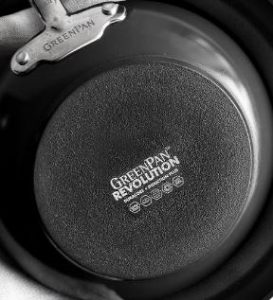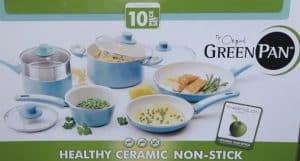GreenPan is a well-liked company that introduced the very first ceramic, non-stick cookware. GreenPan creates cookware that is environmentally friendly, toxin-free, and easy to use. Today we’re discussing the range of a safe Greenpan temperature.
 This cookware brand has many collections and sets of cookware. Each assortment claims to be non-stick and healthy; however, the non-stick pan’s surface can deteriorate if not cared for properly.
This cookware brand has many collections and sets of cookware. Each assortment claims to be non-stick and healthy; however, the non-stick pan’s surface can deteriorate if not cared for properly.
Temperature plays a considerable role in a pan’s non-stick exterior. GreenPan is no exception. Prolonged exposure to high heat makes the non-stick glaze less so.
Choosing the right temperature can make cookware last longer, and it can make cooking food easier.
It is best to learn the right and wrong temperatures to keep cookware in good condition and with a protected surface intact.
Benefits of a Good Temperature
Using the wrong temperature and heat setting can be detrimental to a GreenPan cookware piece. However, there are multiple benefits to using the correct temperature and heat setting! GreenPan has been constructed to ensure exceptional heat conductivity. It can withstand oven temperatures and distribute stovetop temperatures evenly!
Materials – Does GreenPan have Teflon?
GreenPan is made with a material known as Thermolon. With a chemical and mechanical process involving silicon and sand, a Thermolon coating is created. Thermolon is curated to release 60% less CO2 than other non-stick cookware companies that use non-stick glazes.
Using Thermolon is better than other surfaces because it is a better heat conductor than other materials. GreenPan instructs customers to use pans with a low heat setting because a higher heat harms the Thermolon, and the pan will lose its non-stickiness.
Heats Evenly
In addition to the Thermolon glaze, most of GreenPan’s interior structures are built with an aluminum core. Aluminum heats quickly. Another great reason to use a lower heat setting, so food will not burn. Aluminum also heats food evenly.
Particular GreenPan collections have added benefits. Such as the Chatham collection. The Chatham collection has a ceramic glaze that is embedded with a professional grade of diamond dust. Diamonds are an even better heat conductor! The Chatham collection has improved heat transfer and durability.
Oven Safe – Can GreenPan pans go in the oven?
GreenPan strives to be an oven-safe cookware brand. However, there are certain dishes in their collections that are not oven-safe.
The oven-safe factor depends on the handle. GreenPan provides the following information about their oven-safe products:
- Stainless Steel Handles
- Oven safe
- Wood-Be Handle
- Not Oven Safe
- Bakelite Handle
- Oven safe up to 320 degrees F (160 degrees C)
- Stainless Steel Handle Wrapped in Silicone
- Oven safe up to 392 degrees F (200 degrees C)
- Wooden Handle
- Not Oven Safe
- Glass Lid
- Oven safe up to 428 degrees F (220 degrees C)
Some handles are completely oven-safe, others are only safe up to a certain degree, and others are not oven-safe at all. Determine if your pan is oven-safe by its handle.
Temperature Problems to Avoid
Using the incorrect stovetop can cause difficulty when cooking with GreenPan. Choosing the proper heat setting is also crucial to the longevity of a GreenPan dish. If you pick the correct sized burner, heat setting, and stovetop, your pan can stay in tip-top condition!
Induction Stovetops
Similar to the oven-safe feature, not all GreenPan collections are compatible with induction stoves. The following collections are safe to use with induction stoves:
- Venice Pro Collection
- Valencia Pro Collection
Other collections are not made with stainless steel bases. The base allows the magnetic connection to happen between stove and pan. GreenPan’s other collections do not have the proper materials that work with induction stoves.
High Heat
As mentioned previously, high heat settings can harm GreenPan cookware. Thermolon coating distributes heat evenly, and the high heat causes uneven heating.
Not only is the heat distributed unevenly on high heat, but it lessens the non-stick coating. Continually using a high heat setting causes GreenPan to be less efficient.
Burners
It is pertinent to use a burner that has a similar base diameter as the GreenPan cookware. An induction stovetop burner that is too large will make it difficult for the cookware to be acknowledged by the stovetop.
When using a gas stovetop, the flames have to be taken into account. A small pan with high heat will result in a burnt pan. Flames can harm pans if they are used with small pans or high heat.
Rules to Follow
GreenPan suggests that users preheat their pan before using it. Preheating the pan can help keep pans from burning food and from using high heat. To preheat the pan, set the pan on a low or medium setting for just a few seconds. In addition to preheating the pan, GreenPan says to consider letting food reach room temperature before cooking.
help keep pans from burning food and from using high heat. To preheat the pan, set the pan on a low or medium setting for just a few seconds. In addition to preheating the pan, GreenPan says to consider letting food reach room temperature before cooking.
After preheating the pan, only use the pan on a low to medium heat setting. Butter and oil can assist the GreenPan collection in providing a non-stick surface for cooking.
After cooking, let the pan completely cool before washing it. Dunking a hot pan in water can harm the integrity of the pan’s coating. By allowing the pan to cool completely before washing, it will increase the pan’s longevity.
Hopefully, this article has helped you in some way! Did you learn something new about your GreenPan cookware?
